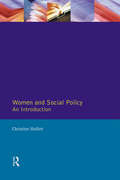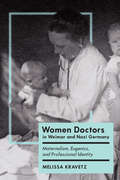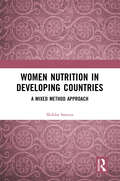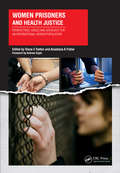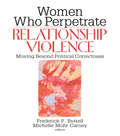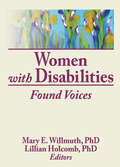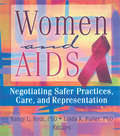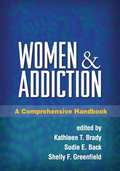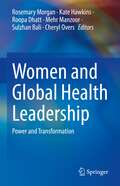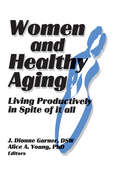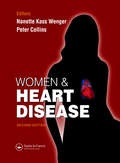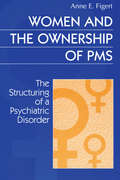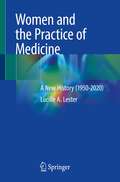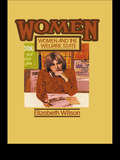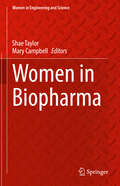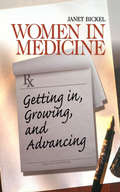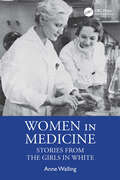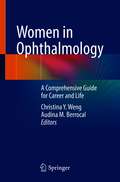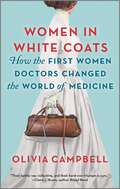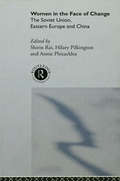- Table View
- List View
Women And Social Policy
by Christine HallettWomen and Social Policy is a major new textbook on women and social policy in Britain in the 1990's. Written by a team of leading academics, the book provides an introduction to the key topics and issues in social policy as they directly affect women as both users and providers of welfare services. All of the main social policy areas are covered: employment, poverty and social security, housing education, health, the personal social services and community care. The book also covers other issues such as race and domestic violence. The book is published in association with the Social Policy Association Women and Social Policy Group.
Women Doctors in Weimar and Nazi Germany: Maternalism, Eugenics, and Professional Identity (German and European Studies)
by Melissa KravetzExamining how German women physicians gained a foothold in the medical profession during the Weimar and Nazi periods, Women Doctors in Weimar and Nazi Germany reveals the continuity in rhetoric, strategy, and tactics of female doctors who worked under both regimes. Melissa Kravetz explains how and why women occupied particular fields within the medical profession, how they presented themselves in their professional writing, and how they reconciled their medical perspectives with their views of the Weimar and later the Nazi state. Focusing primarily on those women who were members of the Bund Deutscher Ärztinnen (League of German Female Physicians or BDÄ), this study shows that female physicians used maternalist and, to a lesser extent, eugenic arguments to make a case for their presence in particular medical spaces. They emphasized gender difference to claim that they were better suited than male practitioners to care for women and children in a range of new medical spaces. During the Weimar Republic, they laid claim to marriage counselling centres, school health reform, and the movements against alcoholism, venereal disease, and prostitution. In the Nazi period, they emphasized their importance to the Bund Deutscher Mädels (League of German Girls), the Reichsmütterdienst (Reich Mothers’ Service), and breast milk collection efforts. Women doctors also tried to instil middle-class values into their working-class patients while fashioning themselves as advocates for lower-class women.
Women Nutrition in Developing Countries: A Mixed Method Approach
by Shikha SaxenaThis book explores the historical perspective of food security, women’s access to food, malnutrition and obesity among women, and household food security to present an analysis of women’s nutrition in developing countries. It also includes a chapter detailing the history of slums – based on the narratives of the key informants. This chapter focuses on the interlink ages between the household food security variables and their temporal relationship with the nutritional status of women in slums of Ghaziabad. The subject matter of this book also covers: Food Security in an Urban Poor Context Socio-Ecological Perspective on Food Sufficiency Inequalities and Caste Discrimination Quest for Determinants of Household Food Security Print edition not for sale in South Asia (India, Sri Lanka, Nepal, Bangladesh, Pakistan or Bhutan)
Women Prisoners and Health Justice: Perspectives, Issues and Advocacy for an International Hidden Population
by Dianne Hatton Anastasia FisherIncarceration severely affects the health and wellbeing of women both during their incarceration and following release, further complicating the health disparities they already experience as a consequence of gender, race and social class. The scope of this international problem remains largely hidden from health professionals and policy makers. This book brings the issues into the light, with contributions from leading advocates, criminologists, feminists, nurses, physicians, public health professionals, social workers, sociologists and former prisoners.
Women Rock Science: A Pocket Guide for Success in Clinical Academic Research Careers
by Megan A. Moreno Rachel KatzenellenbogenThe second edition of this book builds on the success of the first edition, which had many unique features including an emphasis on success in context and how women can thrive in today's clinical research environment. In this new edition, Women Rock Science incorporates promoting inclusivity of gender diverse persons, working in the hybrid world since the COVID-19 pandemic, and the value of diversity, equity and inclusion (DEI), with lessons learned from other women scientists, throughout the book. This book provides key strategies and skills around a central conceptual model as well as a sense of community with other women scientists. Clinical academic research is conducted in many forms, and Women Rock Science speaks to lab-based work, clinical work, health services/implementation science, quality improvement, medical education, health equity, and DEI-focused research throughout its chapters. The approaches and insights addressed are not narrowlyfocused on a discipline or a methodology of research. Rather, Women Rock Science addresses how to achieve excellence in research, across disciplines, within an academic institution. Described as the "unwritten rules" of successfully navigating a clinical academic research career, Women Rock Science is a valuable resource that can be used in a variety of settings. It is beneficial for University classes, lab group meetings, and can be shared with one’s community of mentors, mentees and colleagues.
Women Securing the Future with TIPPSS for Connected Healthcare: Trust, Identity, Privacy, Protection, Safety, Security (Women in Engineering and Science)
by Florence D. HudsonThe second in the Women Securing the Future with TIPPSS series, this book provides insight and expert advice from seventeen women leaders in technology, healthcare and policy to address the challenges of Trust, Identity, Privacy, Protection, Safety and Security (TIPPSS) for connected healthcare, and the growing Internet of Medical Things (IoMT) ecosystem. The ten chapters in this book delve into trust, security and privacy risks in connected healthcare for patients, medical devices, personal and clinical data, healthcare providers and institutions, and provide practical approaches to manage and protect the data, devices, and humans. Cybersecurity, technology and legal experts discuss risks, from data and device hacks to ransomware, and propose approaches to address the challenges including new frameworks for architecting and evaluating medical device and connected hospital cybersecurity. We all need to be aware of the TIPPSS challenges in connected healthcare, and we call upon engineers, device manufacturers, system developers and healthcare providers to ensure trust and manage the risk. Featuring contributions from prominent female experts and role models in technology, cybersecurity, engineering, computer science, data science, business, healthcare, accessibility, research, law, privacy and policy, this book sets the stage to improve security and safety in our increasingly connected world.
Women Who Perpetrate Relationship Violence: Moving Beyond Political Correctness
by Frederick Buttell Michelle Mohr CarneyFind out what drives women to violence in their intimate relationships-and how to prevent itWomen Who Perpetrate Relationship Violence examines the causes and consequences of violence initiated by women against their partners. This unique book fills the void of available literature on domestically violent women, taking a frank look at the issues surrounding female batterers who are the primary aggressors in their intimate relationships. Contributors write candidly about the similarities and differences between violent women and violent men, how to develop effective interventions, existing theories on the development of abusive behavior in women, and society&’s response to violent women.The counseling and psychological community has responded to the problem of domestic abuse and violence against women. But very little has been done to address the issues of domestic abuse and violence committed by women. Women Who Perpetrate Relationship Violence presents innovative original research that focuses specifically on women as offenders, rather than simply adapting programs created for male batterers to women. The book includes epidemiological studies, secondary analyses, personality profiles, and a study of women entering a 16-week, court-mandated, batterer intervention program (BIP). Women Who Perpetrate Relationship Violence examines: predictors of intimate violence, including antisocial criminal records, alcohol abuse, and personality disorders associations between interpersonal dependency and violence elevated histrionic, narcissistic, and compulsive personality traits personality disorders lethal domestic assaults recidivism differences in demographic and psychological variables between women who complete treatment programs and those who drop out and much moreWomen Who Perpetrate Relationship Violence is an invaluable professional resource for psychologists, social workers, and counselors.
Women With Disabilities: Found Voices
by Lillian Holcomb Mary WillmuthHere is a powerful stimulus for thought, discussion, and coalition building in the area of women and disability. This innovative book was written by women with disabilities and women professionals who work with persons with disabilities. Women With Disabilities covers many concerns about life with a disability and issues related to disability and psychotherapy.The authors represent a variety of disabilities, ethnicities, sexualities, and politics. This diversity of experience and perspective forces readers to grapple with contradictions, paradox, and their own preconceptions about disabilities and women. These women writers reveal, in deeply personal, closely technical, and sometimes theoretical terms, how they have coped with the contradictions of being women, of being members of varied colors and classes, and having bodies that don’t “fit.”Women With Disabilities provides a wealth of information for psychologists, social workers, feminist therapists, and counselors working in rehabilitation, vocational rehabilitation, and mental health. It covers a variety of subjects, including transference and countertransference, spinal cord injury, visual impairment, and chronic illness. Some specific topics covered include: therapy issues for therapists working with women with disabilities parenthood and disability use of assistive technology by women with disabilities sexual exploitation of women with disabilities women’s responses to disability at different points in the life cycleReaders will be fascinated by the illuminating depth and breadth of experience expressed by the authors. Voices of rebellion, activism, and resistance sparkle across these pages. Women With Disabilities is an invitation for theoretical, therapeutic, and political coalition building to those with--and without--disabilities.
Women and AIDS: Negotiating Safer Practices, Care, and Representation
by Ellen Cole Esther D Rothblum Nancy Roth Linda K FullerFor many women, the advice “Use a condom!” is not enough to help protect them from HIV infection. As Women and AIDS reveals, “negotiating” safer sex practices is a very complex issue for women who are involved in relationships where they do not enjoy physical, social, or economic equality. The book’s authors maintain that the key to curbing the spread of HIV and to caring for those already infected--is communication. Women and AIDS is the first volume to address HIV/AIDS and women from a communication perspective.This helpful guidebook addresses how women might achieve safer sexual and drug injection practices with partners, but it also explores women’s negotiation of the health care system as patients, medical research subjects, and caregivers. It challenges traditional assumptions about the relationship between care providers and patients and the meaning of patient compliance and raises important questions about gender, race, and class that are exacerbated by the epidemic. Designed to ground interventions in the realities of women’s lives, Women and AIDS discusses what women can do to get around communication and health care obstacles. To this end, you will learn about: using the media for HIV-related social action and to promote women’s views of HIV and sexuality prison health care for HIV-positive women cultural constructions of sex and drug sharing in a variety of communities long-term changes that will empower women delivering an HIV-positive diagnosis to patients gender roles and caregiving the language we use to talk about “Third World” women and “Asian AIDS” women AIDS filmmakers/videographersFor the benefit of AIDS activists, health care providers, and counselors, Women and AIDS discusses women and their communication and awareness from virtually every angle. This book analyzes situations where communication breaks down--from the woman who can’t openly discuss safe sex with her partner, to the drunk college student who “hooks up,” to the doctor who gives an HIV-positive diagnosis without compassion--and offers communication solutions. This will help women avoid such risks, establish communication and safety in their lives, and construct meaningful roles in relationship to HIV/AIDS.
Women and Addiction: A Comprehensive Handbook
by Kathleen Brady Sudie BackFor many years, addiction research focused almost exclusively on men. Yet scientific awareness of sex and gender differences in substance use disorders has grown tremendously in recent decades. This volume brings together leading authorities to review the state of the science and identify key directions for research and clinical practice. Concise, focused chapters illuminate how biological and psychosocial factors influence the etiology and epidemiology of substance use disorders in women; their clinical presentation, course, and psychiatric comorbidities; treatment access; and treatment effectiveness. Prevalent substances of abuse are examined, as are issues facing special populations.
Women and Global Health Leadership: Power and Transformation
by Rosemary Morgan Cheryl Overs Kate Hawkins Roopa Dhatt Mehr Manzoor Sulzhan BaliWomen represent the majority of people working to improve health outcomes in communities, non-governmental and multilateral organizations, both as paid and unpaid health and social care workers. So why is it that when it comes to leadership positions, we have a governance system that privileges men and what can we do to redress the imbalance? This ground-breaking collection explores the leadership roles that women hold in global health, teasing out the routes women have taken to leadership, the challenges they have faced, and what has facilitated their journey. It brings to the fore the stories of women on the frontlines of this struggle from around the world, highlighting and complementing these stories with theoretical and analytical explorations of the structures and systems that help or hinder the process. Among the topics explored: Gendered Institutions in Global Health Gender, Peace, and Health: Promoting Human Security with Women’s Leadership Academic Journal Publishing: A Pathway to Global Health Leadership Women in Health Systems Leadership: Demystifying the Labyrinth Women’s Leadership in Global Health: Evolution Will Not Bring Equality The book is a rallying call to arms to redress gender inequality and celebrate the many ways in which women are taking the lead in supporting the health of their communities internationally. Women and Global Health Leadership is a must-read for those working in or studying global health. It is also a primer that aims to support other women in their efforts and struggles to succeed in a highly unfair and unequal world. The book will engage ministers of health, policy-makers, practitioners, academicians, students, researchers, healthcare workers, health service managers, and members of multilateral organizations. By highlighting key barriers and facilitators to women in global health leadership, organizations can use this book to help inform the development of institutional policies and procedures to support women in leadership positions across academic, health workforce, and global health governance systems. It also can be used within postgraduate courses focusing on the global heath workforce, leadership and management, and women’s studies.
Women and Healthy Aging: Living Productively in Spite of It All
by J Dianne Garner Alice A YoungThis book explores what is known about healthy living among older women, emphasizing overcoming illness and adversity. Women and Healthy Aging focuses on common age-related changes and illnesses that frequently occur among women in the later years. It describes these diseases and changes, provides treatment options, highlights preventative measures, and offers suggestions for continued productive living as women age. Since some of the barriers to effective diagnoses, treatments, and implementation of productive living strategies are institutional, two chapters explore public health policies which affect older women and discrimination against older women in health care. This informative book assists health care professionals in the provision of services to older women, helping these professionals become catalysts for enabling older women to “overcome adversity” and continue to lead healthy, productive lives.Many of the most common diseases and age-related changes that affect older women are not “curable.” In a society which stresses “cure” as the appropriate role for health care professionals, what are these professionals to do with the legions of older women for whom “cures” may not be possible? How can they assist older women in preventing or slowing the occurrences of diseases and age-related changes? When prevention or cure is not possible, how can they assist older women in living productive, meaningful lives?By addressing specific conditions and diseases, Women and Healthy Aging gives readers focused information on current treatment options, preventative strategies, and suggestions for productive living which are disease- or condition-specific and target older women. Some of the topics covered include menopause, osteoporosis, arthritis, diabetes, heart disease, cancer, Alzheimer’s disease, and sensory loss. Practitioners, educators, and students in the fields of nursing, social work, physical therapy, occupational therapy, gerontology, human services, and medicine will find this book an illuminating source of valuable information and insights into the aging process for women.
Women and Heart Disease
by Desmond Julian Nanette WengerDespite being one of the world's biggest killers of women, heart disease is under-diagnosed, under-treated, and under-managed. Why? What is going wrong?Important and ground-breaking, Women and Heart Disease brings our attention to the inadequacies in both the diagnosis and treatment of heart disease in women.Key features:* written by Nanette Wenger and Peter Collins, two of the worlds leading cardiologists* contributions from leaders in women‘s cardiac health* covers all aspects of cardiovascular disease, not just coronary artery disease* fully updated.Building on the success of the best-selling first edition, this is essential reading for all physicians with a particular interest in women and heart disease.
Women and the Ownership of PMS: The Structuring of a Psychiatric Disorder (Social Problems And Social Issues Ser.)
by Anne FigertThis is the first book-length account of the controversy preceding and following the APA’s decision in 1986 to include a premenstrually related diagnosis in its revised diagnostic manual, DSM III-R. Figert examines why the decision was controversial and consequential in three main domains where people, their interests, and claims to ownership coincide: the Health and Mental Health Domain, the Woman Domain, and the Science Domain.
Women and the Practice of Medicine: A New History (1950-2020)
by Lucille A. LesterThis text offers a new interpretation of the dramatic changes that occurred in women in medicine over the course of the last seventy years, starting from the 1950s when women physicians were a curiosity to the present day when their presence is accepted and their achievements are broadly acknowledged. In seven chapters arranged by decades, this book examines the seminal events that shaped what has been described as “the changing face of medicine.” Using the lived experiences of women physicians featured as vignettes throughout the narrative, the book traces the effects of the quota system for admissions, second wave feminism and Title IX legislation, the restrictions of the “glass ceiling,” and a cascade of “equity issues” in career advancement and salary to offer a new account of the roles women played in shaping the standards and the contributing to progress in the field of medicine. Women faced gender specific challenges to enter, train and practice medicine that did not abate as they strove to balance work and family. As the book shows, such challenges and the attendant institutional responses offered by medical schools and government rulings shaped how women “do” medicine differently. Women and the Practice of Medicine offers a unique interpretation of this history and accounts for the changes in social norms as well as in women’s perspectives that have made them an invaluable “new normal” in the contemporary world of medicine. This book fills a gap in the more recent history of women in medicine, much of which is written by academic historians or sociologists; this book contributes a clinician’s “on the ground” point of view. It includes a researched, structured historical narrative spanning the last 70 years, but it seeks to frame this narrative with the personal stories and accomplishments of women physicians who lived through the time in question. The book also provides an overview of how much has changed in the practice of medicine as well as a reminder of what has not changed and what needs to further evolve for women to be equitable partners in medicine as well as other professional disciplines. The book concludes with two appendices containing a questionnaire used in interviews of 40 women conducted at the start of the book project, and a summary of the qualitative findings from the semi-structured interviews.
Women and the Welfare State
by Elizabeth WilsonWomen and the Welfare State approaches the question of welfare policy from an entirely fresh perspective. In it the author argues that an appreciation of the way in which women are defined by welfare policies, and have been since the beginnings of the Industrial Revolution, is essential to a true understanding of the nature of those policies and of the Welfare State. An important, possible the most important, function of welfare policy has been to promote and retain a particular form of the family; indeed, one can define the Welfare State as the State organization of domestic life. To illustrate her arguments the author looks at the development of State welfare intervention from the early nineteenth century to the present day and relates it to the changing position of women, children, and of the family. The traditional Marxist view is modified by a theory of the position of women and by relating changing welfare policies and beliefs about welfare both to the women’s movements of the past century and to the ideas and theories of the contemporary Women’s Liberation Movement. In her approach Elizabeth Wilson argues – uniquely among writers on the Welfare State – for an emphasis on the ideology of welfare.
Women at War
by Elizabeth NormanNorman tells the dramatic story of fifty women--members of the Army, Navy, and Air Force Nurse Corps--who went to war, working in military hospitals, aboard ships, and with air evacuation squadrons during the Vietnam War. Here, in a moving narrative, the women talk about why they went to war, the experiences they had while they were there, and how war affected them physically, emotionally, and spiritually.
Women in Academic Psychiatry
by Sophia FrangouThis text comprises of sixteen first-person narratives from some of the most influential women in psychiatry about why they went into the field, what they attribute to success, and how they overcame their challenges. The second part of this text analyzes the themes brought to light in the narrative and discusses strategies for success. Though several of the chapters target issues that women in academic psychiatry may not have a resource for, several of the chapters discuss challenges that both men and women face, including strategic actions and decisions and the time investment necessary for a successful career in academic psychiatry. The topics are relevant to medical professionals at every level of their career who are or work with women in the field. Women in Academic Psychiatry is a unique resource for the professional woman in psychiatry, psychology, medical school, for men who face particular career challenges in academic medicine or are cultivating young women who are eager to succeed.
Women in Biopharma (Women in Engineering and Science)
by Mary Campbell Shae TaylorThis book provides the perspectives of many different stakeholders in the biopharmaceuticals field, who share knowledge, challenges, and solutions in an ever-shifting career landscape. Interwoven with discussions of vaccines, gene therapies, recombinant therapeutic proteins, and cell therapies are stories from female scientists working in the field. Authors come from a wide variety of areas within the biopharmaceutical market including researchers, sales, investors, and auditors and from individuals at different points in their career – from new graduates just starting their careers, to mid-career leaders to retirees. As an important part of the Women in Engineering and Science book series, the work highlights the contribution of women leaders in biopharma, inspiring women and men, girls and boys to enter and apply themselves to secure our future in.
Women in Medicine: Getting In, Growing, and Advancing
by Ms Janet BickelWomen in Medicine is a concise, practical resource for anyone considering a medical career, but especially women. Drawing on all the best available literature and the experience of thousands of women doctors, the book covers: getting into medical school; overcoming gender stereotypes; finding a mentor; combining parenting with a career; and maximising career development. The author also offers tips on building key professional skills, and a self-diagnostic section for readers who are preparing to begin a medical career.
Women in Medicine: Stories from the Girls in White
by Anne WallingIn telling the history of women in medicine, the pioneers (especially the turbulent ones) are rightly remembered and celebrated in books, articles, memorials, awards, names of buildings, and organizations – even in stone statues and memorials. In contrast, the generation who began the transition from minority status to the current numerical equity are seldom memorialized, yet without the efforts of these few determined women in what was unambiguously a male profession, the achievements of these pioneers could easily have withered.This book is written to celebrate this unique generation of women who entered medicine between the Second World War and the early 1970s – determined women who just wanted to be doctors but ended up fundamentally changing the profession. Utilizing oral histories from 37 women who became physicians between 1948 and 1975, these women tell their stories in their own words and provide a valid picture of their experiences throughout their careers that has much resonance for those entering or practicing medicine today. Women in Medicine: Stories from the Girls in White will be of interest to all health professionals or those considering entering health professions, particularly women, and their advisers and supporters, to medical educators, and to medical historians seeking to understand the progress of women in medicine and other professions since the end of WWII.
Women in Ophthalmology: A Comprehensive Guide for Career and Life
by Christina Y. Weng Audina M. BerrocalThere are nearly 24,000 ophthalmologists in the United States, with 500 physicians newly entering the ophthalmology field each year and approximately half of those being women. Although women now represent approximately half of all ophthalmologists, gender disparities remain when it comes to certain subspecialties (e.g., surgical retina), leadership roles (e.g., department chairs), industry involvement (e.g., consultancy and advisory board positions), and even academic publications. There has been a recently heightened interest in female representation in this field which has manifested in several ways (e.g., conferences geared towards women in ophthalmology, non-peer-reviewed publications about women in ophthalmology, and mentorship programs specifically for women). This book is the first of its kind in procuring and disseminating information—pertaining to both career and life—in an organized, concrete, and enduring way. Women in Ophthalmology is a comprehensive collection of chapters primarily written by women in the field of ophthalmology. The book aims to guide others through milestones and challenges women may face during their careers, and shares sound insights into how to deal with unique issues both inside and outside the workplace. Topics that are widely applicable to all who work in ophthalmology are included, such as finding mentors, collaborating within industry, handling work-life balance, and seeking out leadership opportunities. Each chapter combines personal anecdotes with knowledge from leaders in the field which both men and women will find highly valuable.
Women in Pediatrics: The Past, Present and Future
by Nancy D. Spector Jennifer K. O’Toole Barbara OverholserWomen comprise the majority of pediatricians in the United States and yet there has been slow progress in leadership diversity and equity in the field overall. While there have been many academic journal articles that examine women’s roles, challenges and successes in the field, there is not one, overarching book that follows the path of women into the profession, the challenges they encountered in the early years – and still encounter - the successes they’ve had, and what the future might look like. This book fills that gap in medical literature.Because women are so well-represented in the field, one would think that pediatrics should be leading the way in gender equity achievements, but this is not the case. This text examines the disparities, the boundaries that are in place, the impact of intersectionality on equity, the toll gender discrimination has on the health and wellness of women in pediatrics, and best practices that can help achieve gender equity in the field. The COVID-19 pandemic has exacerbated the disparities that women, and in particular women with intersectionality, face. This book also examines the immediate impact of the pandemic on women in pediatrics, what future implications may be, and how we can potentially mitigate them. Equity strategies that can be implemented by healthcare institutions, professional societies and other medical organizations are also discussed.The book is divided into three main sections. The first section gives an overview of the history of women in pediatrics by describing stories of early leaders and the early days of women in pediatrics. The second section reviews the current state of affairs in women in pediatrics. Chapters in this section detail women entering and practicing in pediatrics; leadership; women of color; women conducting research; national campaigns and efforts focused on gender equity; and childbearing, adoption, motherhood and eldercare by women in pediatrics. The final section describes the future of women in pediatrics. The seven chapters in this section discuss leaders in pediatrics supporting women; policies and programs to advance equity; allies in gender equity efforts; research, funding and publication for women; networking, mentorship, sponsorship, coaching, and career development activities; advocacy efforts; and supporting the health and wellbeing of women in pediatrics.Written by experts in the field, Women in Pediatrics is a valuable resource for all pediatricians in academic or community-based medicine, as well as those involved in pediatric sub-specialties. On a broader level, this text is also of interest to all other women involved in medicine and science.
Women in White Coats: How the First Women Doctors Changed the World of Medicine
by Olivia CampbellNEW YORK TIMES BESTSELLER!For fans of Hidden Figures and Radium Girls comes the remarkable story of three Victorian women who broke down barriers in the medical field to become the first women doctors, revolutionizing the way women receive health care. In the early 1800s, women were dying in large numbers from treatable diseases because they avoided receiving medical care. Examinations performed by male doctors were often demeaning and even painful. In addition, women faced stigma from illness—a diagnosis could greatly limit their ability to find husbands, jobs or be received in polite society.Motivated by personal loss and frustration over inadequate medical care, Elizabeth Blackwell, Elizabeth Garrett Anderson and Sophia Jex-Blake fought for a woman&’s place in the male-dominated medical field. For the first time ever, Women in White Coats tells the complete history of these three pioneering women who, despite countless obstacles, earned medical degrees and paved the way for other women to do the same. Though very different in personality and circumstance, together these women built women-run hospitals and teaching colleges—creating for the first time medical care for women by women.With gripping storytelling based on extensive research and access to archival documents, Women in White Coats tells the courageous history these women made by becoming doctors, detailing the boundaries they broke of gender and science to reshape how we receive medical care today.
Women in the Face of Change: Soviet Union, Eastern Europe and China
by Hilary Pilkington Shirin Rai Annie PhizackleaFirst Published in 1992. Routledge is an imprint of Taylor & Francis, an informa company.
